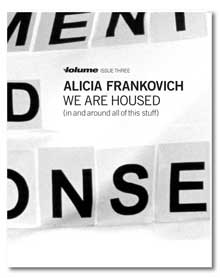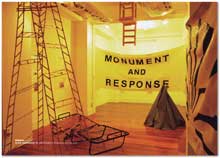 |
|||||||||
|
|
| ...Publications: Volume | ...Alicia Frankovich | ||||||||||||||||
|
Alicia Frankovich if we’re gonna talk about the stray as a constitutive being, a mobile, parable unit keenly affinitive and yet residually inert to the domestic scene, then it’s definitely gonna be worth looking at the urban order of decay. which, handily enough, is where Alicia Frankovich’s project for The Physics Room’s Volume series is situated. yeah sure, there’s other issues circulating around the work but, perhaps, at its founding inception is this conflation of urban capitalist order with the domestic scene of the late modern individual. call it consumer politics if you want, but you can’t spray the word ‘property’ on onion bags, hoist vacuum seal, self-storage-units and then feign domestic interiors with a broken dilapidated fold out mattress without some kind of notion of what Walead Beshty has called ‘the perennial anxiety of late capitalism’, that consumptive anomalisation and conflation of identity with market place saturation. but this isn’t really anything new, as with everything modern, it’s been embedded within the very order of modernity’s linear roll. take Walter Benjamin’s reading of the flâneur, that cultural agent of capitalism’s leisure domain whose indolence, marks out an ‘empathy with the commodity’ as a kind of final ambit, in which the very concept of marketability is taken for a stroll. more recently though, Benjamin’s flâneur figure has been re-cast from what one could call the rosy character of capitalism’s consensual consumer, to become, instead a figure of entropy who not only precedes but also codes modernity’s own failings. as best exemplified by Tom McDonough’s essay, The Crimes of the Flâneur, it is better to see the flâneur as a doubled cultural agent who highlights “the tenuous nature of urban order; the way that our everyday routines are always subtended by other possibilities”. throughout the following then I want to follow a thread which might exacerbate the cultural condition of the flâneur, suggesting that though the domestic ordeal is complicit with capitalism’s constitutional pull, there also exists what Mathew Hyland calls, ‘defective wit’, a strategy keenly displayed in the furtive, anticipative procedures of Frankovich’s practice. ‘better living...’ take the latest, long running Glad ads , it’s all conflation. the modern product is subsumed into conditional living. sped up, becomes hyper-live. instant, impeccable and addressed to you. just as this is. we read from the page in instant access, conflating understanding with wit, incredulity, discernment. we’re subsumed into the very matter, the constitutional appeasement of consumption. Hal Foster writes this better: “In Lifestyle (2000), a compendium of his work, Canadian designer Bruce Mau asks us to think design as ‘life style’ in the philosophical sense of the Greeks, Nietzsche, or Foucault, that is, as an ethics. But the style of Lifestyle is closer in spirit to Martha Stewart—a folding of the ‘examined life’ into the ‘designed life’. Such style does not boost our ‘character,’ as Lifestyle claims; rather, it aids the contemporary conflation of the realisation of self with the consumption of identity”. taking this premise into the realms of the public domain of contemporary urban reality Rem Koolhaas suggests that Modernisation has run its course, leaving us within the inert, noxious terrain of Junkspace... Junkspace is the body double of space, a territory of impaired vision, limited expectation, reduced earnestness. Junkspace is a Bermuda Triangle of concepts, an abandoned petri dish: it cancels distinctions, undermines resolve, confuses intention with realisation. It replaces hierarchy with accumulation, composition with addition. More and more, more is more. Junkspace is overripe and under-nourishing at the same time, a colossal security blanket that covers the earth in a stranglehold of seduction... Koolhaas suggests that Junkspace is the ‘continuity’, the ‘built product’, the coagulation of the rational, empirical plan of progress. caught in such a bind, Junkspace renders endeavour inert, forcing creativity to become ‘regurgitation’, an ‘embrace of manipulation’ in which all ‘materialisation is provisional’. in this sense, Junkspace is both a proponent and causative of what Mathew Hyland and JJ King have called “the vile regime of the ‘look’, [the] sheer spectacularity of identity”. writing again, against this subjugation, Hyland suggests that the “social subject-object of deformation cannot rationally plan the counter-adaptation that would wreck ‘self’ for valorising. If it hopes to turn illness into a weapon against capitalist evolution it must live by its defective wits”. just what those wits might look like are happily played out in the ‘lethargy rhetoric’ of Frankovich’s work. by blocking the entranceway Frankovich forced her work to become a room into itself. you couldn’t just walk into her room, you had to do it intentionally. as Don DeLillo points out, “the point of rooms is that they’re inside. No one should go into a room unless he understands this. People behave one way in rooms, another way in streets, parks and ports. To enter a room is to agree to a certain kind of behaviour”. Frankovich built on this concept through a jumble of cobbled design that’s half-critique and half earnest appeasement. which suggests that Frankovich’s work isn’t lethargic at all, merely symptomatic. after all it is considered, it’s certainly accumulative, saturated, manipulative. it employs dispersion, accretion, buttresses commodity against form, exploits use-value and design as marketability. such strategies may come off as half measures, entropic deceits, but such readings draft that ‘shabby thesis’ which “conceals the true motives of flâneur”. Benjamin writes against a perceived transparency of modern architecture and celebrates instead “an ancient culture of dwelling” which resists the stream-lined anomisation of consumptive desire. yet in this sense, the flâneur was an ambivalent figure caught within the very mesh of the market-place expectation through the duration and expenditure of leisure time. in this sense, the flâneur appropriates an air of the ornamental, which under a bourgeois morality would just be ‘the philosopher out for a stroll’, but under both Hyland and Benjamin’s optimistic model the flâneur becomes ‘the werewolf at large in the social jungle’. according to McDonough this concept of the flâneur comes into its own when “a breakdown in the normative bourgeois conception of urban order [provokes] a return to the streets”. which is roughly what Hyland anticipates by urging defective wit. but if all this sounds didactic, a kind of better living through art, perhaps you should just try sleeping on that couch. which is not the point i suppose. i, for one, would rather rebound through the work in a kind of continual cycle of inevitability. call it modernity’s gloom, hell, call it Junkspace, but at least it’s amusing. Harold Grieves Alicia Frankovich completed a Bachelor of Visual Arts in Sculpture at Auckland University of Technology, New Zealand, in 2002, and is currently a studio artist at Gertrude Contemporary Art Spaces, Melbourne. Recent solo shows include, Standard Apparatus, CLUBSproject, Melbourne, 2005; Deuce, MOP Projects, Sydney, 2005; Alicia Frankovich, Rm. 103, Auckland, 2004; A Kelly Frankovich Production, Conical Inc., Melbourne, 2004; and Produnova Stadium, MOP Projects, Sydney, 2003. Selected group shows include, Short Ride in a Fast Car, Gertrude Contemporary Art Spaces, Melbourne, 2005; www, Kaliman Gallery, Sydney, 2005; Manoeuvre, St. Paul St. Gallery, Auckland, 2004; Lost in Translation, Small Gallery, CalArts Valencia, USA, 2004; MOP LOG, MOP Projects, Sydney, 2003. Harold Grieves is a walking somnambulist. He dreams slowly in his sleep. Photo credit: Mark Gore. Design: Aaron Beehre somewhere along the way the stray has become a pet subject. i blame animal studies, but lately it’s been popping up in both the street literate subject and the technological sublime, see, ‘Kim Swanson’s stud-hood’ (High Street Project, Christchurch, May 2005) and ‘i wanna be zapped’ (SOFA, Christchurch, September 2005). Beshty writes, ”our own surroundings are tailored to our desires, our sense of self is externalised to the point of complete erasure. We fear becoming as inhuman as the objects that are meant to reflect our deepest aspirations and desires anominisation”. from ‘Notes on the Subject Without Qualities: From the Cowboy Flâneur to Mr Smith‘, Afterall, (8), p.125. Walter Benjamin, The Arcades Project, trans. Howard Eiland and Kevin McLaughlin, Cambridge, Massachusetts, and London, England: The Belknap Press of Harvard University, 1999, p.448. Glad product advertisements, which are still running, centre on the slogan ‘better living everyone’. the Glad website states “Managing your busy life is a challenge, but managing your kitchen doesn't have to be. Glad can help. Every time you try a new recipe, pack those school lunches, throw a dinner party, or even clean out the fridge, we've got just the right GLAD® product to help make your chores a little bit easier. How do you like them apples?”. Retrieved from www.glad.com, 07/09/05. J.J. King, with Matthew Hyland, ’Seventeen Reduced Propositions for Francis Upritchard‘, Doomed, Doomed, All Doomed, ARTSPACE exhibition catalogue, Auckland, February, 2005. there’s a sense to which this is lazy, generic quoting on my behalf, but the more I think about it, the more I think it’s right, see, www.imageandtext.org.nz/alicia.html Benjamin writes against the rubberneck who disappears into the crowd, ‘who is absorbed by the external world’, distinguishing the flâneur as a devotee to ‘that ancient dream of humanity, the labyrinth’. see Arcades Project, pp. 429-430.
Alicia Frankovich: View WE ARE HOUSED (in and around all of this stuff) as a PDF [492 KB] Related 24 August - 17 September 2005
|
||||||||||||||||

